Readings for Week 4
Please Log In for full access to the web site.
Note that this link will take you to an external site (https://shimmer.mit.edu) to authenticate, and then you will be redirected back to this page.
Licensing Information

The readings for 6.S090 are licensed under a Creative Commons Attribution-NonCommercial-ShareAlike 4.0 International License. You are free to make and share verbatim copies (or modified versions) under the terms of that license.
Portions of these readings were modified or copied verbatim from the very nice book Think Python 2e by Allen Downey.
PDF of these readings also available to download: reading4.pdf
Table of Contents
So far, we have learned about a number of useful tools in Python. We have learned about:
- several types of Python objects that allow us to represent a
variety of things in Python's memory (the types we have seen so far
include numbers, strings, Booleans, the special
Nonevalue, and compound objects like lists, tuples, and dictionaries); and - several control flow mechanisms that allow us control over the
order in which statements in a Python program are executed (the
control flow mechanisms we have seen so far include
if/elif/else, andwhileandforloops).
These are some really powerful tools, and, as you've seen through the exercises, they are enough to accomplish a wide variety of things!1 However, this week, we'll learn about an incredibly powerful means of abstraction that will help you manage the complexity as the programs you write become more and more complicated: functions.
Let's start our discussion of functions by considering the following code, which is designed to compute the result of evaluating a polynomial (represented as a list of coefficients) at a particular numerical value:
coeffs = [7, 9, 2, 3] # represents 7 + 9x + 2x^2 + 3x^3
x = 4.2
result = 0
for index in range(len(coeffs)):
result = result + coeffs[index] * x ** index
print(result)
This is a nice piece of code in the context of a program that requires
evaluating a polynomial, but in some sense it isn't as useful as it
could be, in that it works only for the values of coeffs and x
given above.
It is possible, however, to imagine a larger program that requires
evaluating several polynomials. With the tools we have available to
us so far, if we wanted to use the code above to this end, we
would have to copy the code and paste it to new locations several times.
Depending on what our program is doing, we might need to
change the variable names coeffs, x, and result to prevent them
from overwriting values we had computed for other polynomials. This
is a pain! Not to mention, if we find a bug in our implementation, we
would have to go back and fix it in every copy-pasted copy we made of
this code!
It would be nice to be able to generalize the notion of this computation so that we could perform it on arbitrary inputs as part of a larger program. It turns out that a new type of Python object called a function, will allow us to do this!
Functions are arguably the most powerful tool any programmer can have in their toolkit, but it can be a bit complicated to keep track of how Python handles them. As such, we're going to introduce relatively few new topics in this section, so that we can focus on functions, on how Python goes about evaluating code inside a function, and on how they can be used to increase the modularity of the programs we write.
A function is a type of Python object that represents an abstract computation. It can help to think of a function as a little program unto itself, which performs a specific task. Internally, that's what a function really is: it is a generalized sequence of statements that Python can evaluate to compute a result. This is perhaps not the most elegant definition in the world, so let's move on by way of example.
Python comes with several functions built in, and, in fact, we have
already seen several examples of functions in Python. For example, we
already learned about len, which computes the length of an input
sequence. We could use len inside of a program, for example, by
evaluating the following expression: len("twine")
In this example, the name of the function we are working with is len.
The parentheses indicate that we want to "call" the
function2, which means to evaluate the
sequence of statements it represents. The expression inside the
parentheses (here, "twine") is called an argument3 to the function.
In this case, the result is an integer representing the length of the
argument.
It is common to say that a function "takes" one or more arguments as
input and "returns" a result. This result is also called the return
value. In this case, len is a function object, and the result of
calling it is an int. But, importantly, functions can return values
of any type!4
We can treat the result of calling a function the same way we would treat any other Python object. For example, we could:
print(len("twine")) # print the result
x = len("yarn") # store the result in a variable
y = len("thread") + 27/2 # combine the result with other operations.
Some functions take more than one argument. To specify this, we
separate arguments with commas inside the parentheses associated with
a function call. For example, consider Python's built-in divmod
function, which takes two arguments:
print(divmod(19, 4)) # divmod returns a tuple; this will print (4, 3)
This is something of an aside, but it is worth mentioning that Python
provides documentation for all of its built-ins, which can be very
helpful when determining how to use functions from Python. For
example, see the section on divmod.
It turns out that two of the functions we have already dealt with have alternate forms that take more than one argument, which may be useful in your programs moving forward:
- If
printis given more than one argument, it will print all of its arguments on the same line, separated by spaces. If it is given no arguments (i.e.,print()), it will simply make a blank line. rangehas three forms:-
If
rangeis given a single integer x, the object it returns contains the numbers from 0 to x-1, inclusive. -
If
rangeis given two integers x and y, the object it returns contains the numbers from x to y-1, inclusive. -
If
rangeis given three integers x, y, and z, the object it returns contains all values x + i\times z such that x \leq x + i\times z \lt y, in increasing order of i. We can think of z as the step size that we take to go from x to y. This form is commonly used to iterate backwards:range(10, 0, -1).
-
Experiment with these various forms to get a sense of how they behave. Try printing multiple values on a single line. Try printing several ranges. Since range does not return a list (but, rather, a special range object), you need to convert that object to a list or tuple to see the objects inside of it (for example, list(range(9)) or tuple(range(1, 4))).
As we see above, print is a function, as well! What is the return
value of print? Try storing the result of a call to print in a
variable, and then displaying it (again with print!).
x = print(7)
print(x)
The first line stores the result of calling print(7) in a variable
x. Then, on the next line, when we print x, and we see the
following: None. So print will display its arguments to the
screen, but then it will return None.
print was our first example of an impure function (or, said another
way, a function with "side effects"). Not only did it return None,
but it also had the effect of displaying something to the screen.
What will the following piece of code print?
print(print(print(10)))
In evaluating this code, the first function call Python actually evaluates is the inner-most print(10). This will display a 10 to the screen, and will return None. So after evaluating that expression, we are left with: print(print(None)).
Python then evaluates the inner-most print(None). This will display None to the screen and will also return None. After evaluating that expression, we are left with: print(None), which displays yet another None to the screen.
All things considered, this code will have printed:
10
None
None
Before we can go too much farther, we need to think about how Python evaluates functions in our substitution model. In order to evaluate a function call, Python takes the following steps:
- Looks up the value to the left of the parentheses
- Evaluates each of the arguments from left to right
- Calls the function with the results of evaluating the arguments
Use the substitution model to predict the result of evaluating the following expression:
divmod(17 + 2.0, len("ca" + "ts"))
divmod to find the built-in function.
Then it moves on to evaluating the arguments, from left to right.
The first argument evaluates as we might expect: 17 + 2.0 becomes 19.0.
So after this evaluation, our overall expression looks like:
divmod(19.0, len("ca" + "ts"))
In order to evaluate the second argument, we need to evaluate
another function call! Here, Python looks up len and finds the
built-in function, and then moves on to evaluating the arguments to
len.
There is only one argument to len, the result of concatenating "ca" and "ts", which makes our overall expression:
divmod(19.0, len("cats"))
Still in the process of evaluating the second argument to divmod, Python
calls len and replaces the function call with its return value:
divmod(19.0, 4)
Finally Python can call divmod on these two arguments, which gives us:
(4.0, 3.0)
(Don't worry if you didn't know that both of these would be floats; that's an implementation detail of Python's divmod function.)
What happens when you try to run the following piece of code? Why did that happen?
x = 2
z = x(3.0 + 4.0)
print(z)
TypeError: 'int' object is not callable. In
typical Pyton fashion, this is perhaps a little bit obtuse. But what
Python is trying to say is: you tried to call something by using
parentheses, but instead of being a function, the thing you were
trying to call was actually an int. Since Python doesn't know what
it means to call an int, we see this error.
So how did Python get to that point? Let's use our substitution model
to find out. We'll start with x(3.0 + 4.0). Python will start by
looking up the value of x, and finding 2, which leaves us with:
2(3.0 + 4.0). Next, Python will evaluate the value inside the
parentheses, giving 2(7.0). Next, Python proceeds by attempting to
call 2 with 7.0 as an argument. Since 2 is not a function, it
is not clear exactly what this means, and so Python gives us an error.
Presumably, the code above was intended to multiply 2 and
3.0+4.0 rather than calling 2 with 3.0+4.0 as an argument. But
Python isn't that smart, so we have to be very explicit if that's what
we want (in this case, we have to include a * to indicate
muiltiplication).
Using built-in functions or functions imported from Python modules is
all well and good, but real power comes from being able to define
functions of your own. This is accomplished via a new kind of Python
statement called a function definition statement, which uses a
Python keyword called def.5
This is perhaps best seen by example:
def maximum(x, y):
if x > y:
z = x
else:
z = y
return z
This statement does two things:
- it creates a new
functionobject in memory, and - it associates the name
maximumwith that object in the current frame.
A function definition statement always starts with the keyword def,
followed by an arbitrary name for the function. The sequence of names
within the parentheses after the function's name are called
parameters or, interchangeably, arguments (in this case, x and y), and the function describes a
computation in terms of those parameters (as well as, potentially,
other values, constants, etc).
Like many of the structures we have seen, function definitions also
have a body (all the code that is indented one level farther than
def; in this case, the whole if/else statement). The return
keyword, which is only usable inside a function definition, tells
Python what the function should produce as its return value when it
is called.
Importantly, this statement only defines the function; Python does not run the code in the function body yet! It simply makes an object that represents this function and associates the given name with that object.
As with every new object we've introduced, we'll need a way to represent these objects in memory. Functions need to keep track of three pieces of information, and we'll try to depict all of those in our representation:
- The names of the parameters to the function, in order;
- The code in the body of the function; and
- The frame in which the function was defined.
The following shows an example environment diagram that would result after executing the function definition statement above:
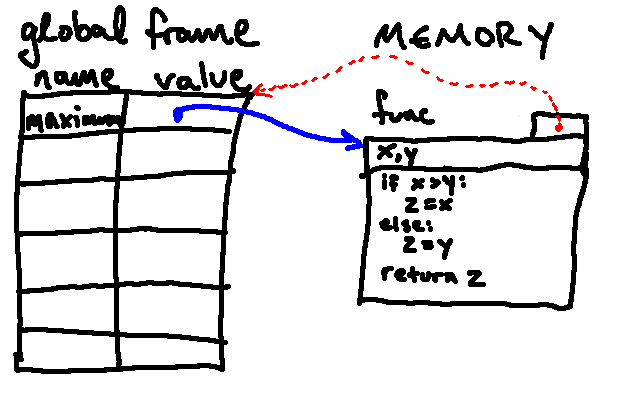
A few notes about this drawing:
- Note that the function definition did two things: it created a new function object, and it bound the name
maximumto that object in the global frame. - The names
x,yon the top line of the function object represent the parameters of the function. - The red arrow points back to the frame in which the function was originally defined (in this case, the global frame).
We can then call this function just as we would with any of the built-in functions (or imported functions) we've seen so far. For example:
a = 7.0
b = 8.0
x = 3.0
y = 4.0
c = maximum(a, b)
We'll now spend some time learning about what happens when this function is called. In the simplest terms, this is what happens:
- First, Python looks up the name
maximumand finds the function object in memory. - Next, Python runs the code in the function body with the
parameters replaced with the values given (here, the body of the
function would be evaluated with
xreplaced by7.0andyreplaced by8.0) until either areturnstatement or the end of the body is reached. If areturnstatement was reached, execution of the function stops and the associated value is returned; if the end of the function was reached (without hitting areturnstatement), the function returnsNone.
So after running the code above, c will have value 8.0.
That said, it will be important for us to understand how exactly Python got to that result, and so we'll go into more detail on these steps in the next section. Grab a cup of tea and settle in! This will get complicated, but understanding it is crucial to understanding some of the behaviors we will see from Python in the future! Don't be afraid to re-read multiple times, and, of course, to ask questions if you are confused!
We now examine what happens when a user-defined function is called. We'll go through the example from above. In next week's readings, we'll explore more complex examples.
Here is the code (repeated from above) for our example:
a = 7.0
b = 8.0
x = 3.0
y = 4.0
c = maximum(a, b)
(Assume that maximum has already been defined as above)
We know how the first four lines will behave: Python will associate the
names a, b, x, and y with the values 7.0, 8.0, 3.0, and 4.0, respectively, in
memory, resulting in the following environment diagram:
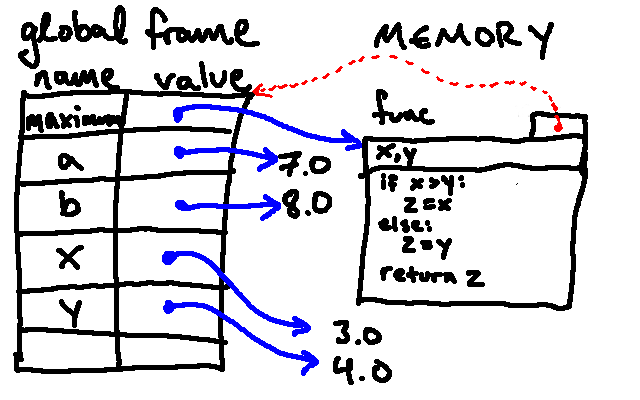
Now we are on to the line where the function call is evaluated. To accomplish this evaluation, Python completes the following steps:
-
As we saw with built-in functions, Python first starts by evaluating the name
maximum(finding thefunctionobject), followed by the arguments to the function (which evaluate to the7.0and8.0thataandb, respectively, point to). -
This is where things get different. Python's next step when calling a user-defined function is to create a new frame. This frame will be similar to the global frame in that it will map names to variables, but these variables will be local to the function (i.e. they will only be accessible inside the function being called).
Once this new frame is created, Python binds the names of the parameters to the argument that were passed in to the function. From this point on, variable lookups will happen inside this new frame (until the function is done executing).
This frame also contains a "parent pointer" to the environment in which the function being called was defined.6
Once this step is done, we will have an environment diagram like the following:
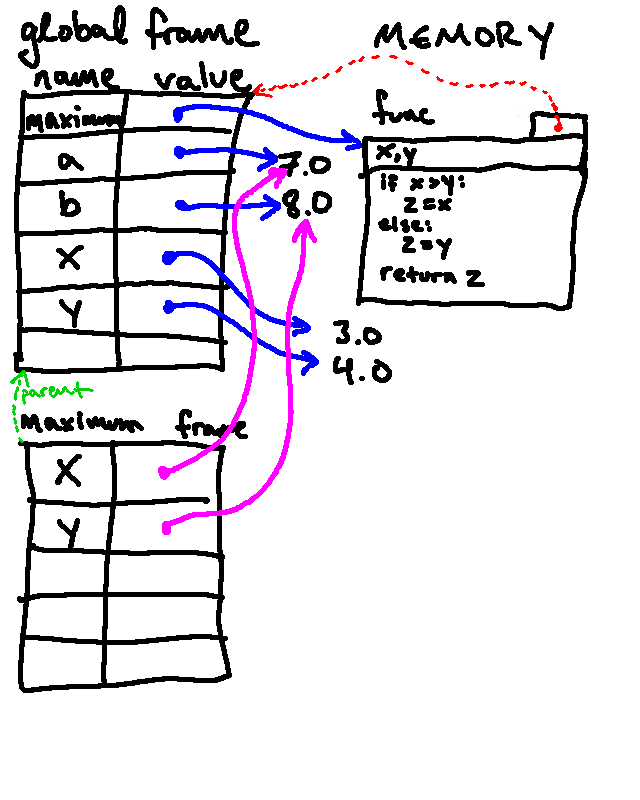
As promised, this is a bit complicated. The frame in the bottom-left contains the bindings that exist inside the function. The green arrow represents the "parent pointer."
-
Python then executes the body of the function within this new frame. This means that, if Python looks up
x, it finds the value7.0(bound in this frame), rather than the3.0value that is bound in the global frame. When looking up a variable, if it is not found in the current frame, Python then continues looking for that name in the parent frame before giving up.In the process of executing the function body, if Python makes any new assignments, those are also made in the current frame.
So when our example code assigns a value to the variable
z, that binding is made in the current frame. In the course of executing the conditional, we assignzto the same value asy, which results in the following environment diagram: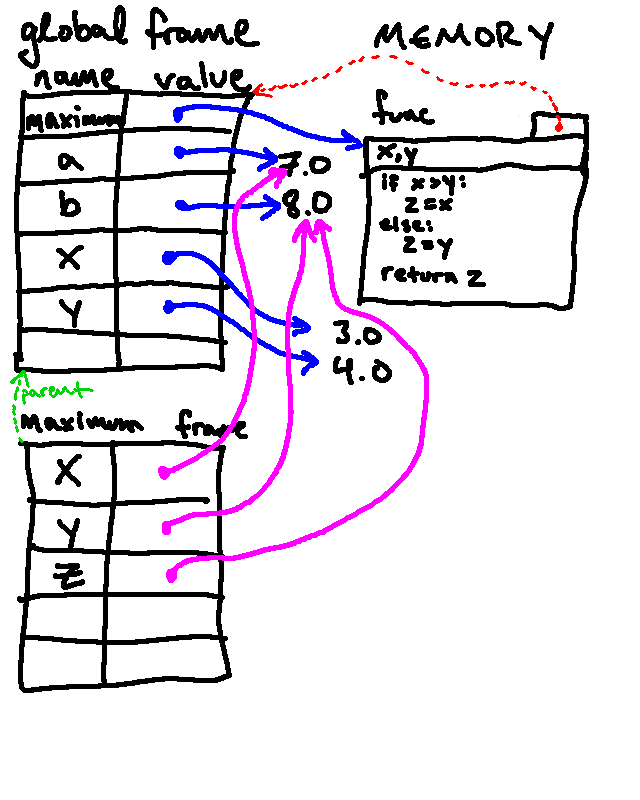
-
When the body is over or a
returnstatement is reached, Python notes the value to be returned. (In the below diagram, the red "return" does not indicate an actual new variables called "return"; rather, it simply indicates the value that is to be returned from the function). Here, the return value wasz, which pointed to the8.0currently in memory, so that is the value that will be available as the result of calling this function: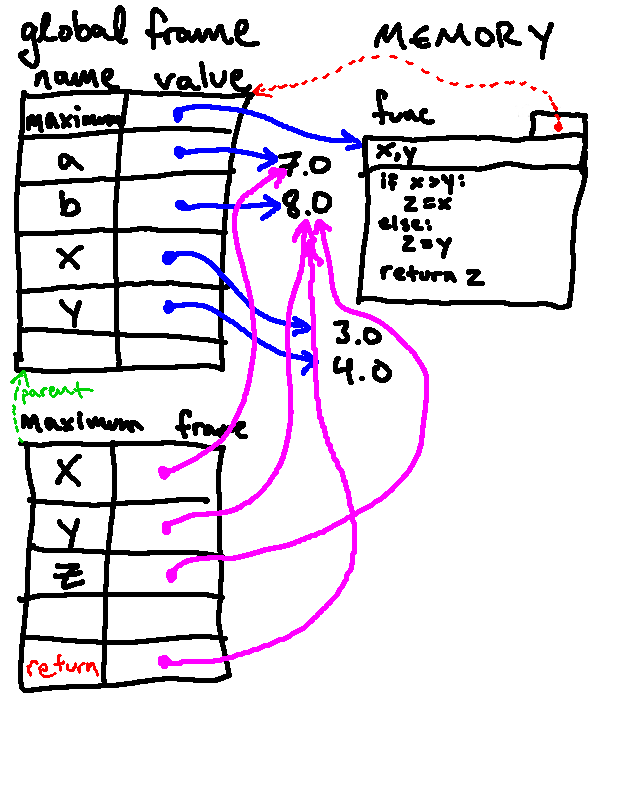
Python then stops executing this function and returns to executing in the frame from which the function was called, after returning the value in question. It also cleans up the new frame it created7. In our example from above, the return value is then associated with the name
cin the global frame, leaving us with the following:
Notice that above, the process of creating the new frame gave us a
wonderful feature: the variables inside the function body don't
affect the variables outside the function body. This allowed us to
call something x inside the function body and not have that cause
problems with the thing called x outside the function (when the
function is done executing, if we print x, we see the 3.0 that was
assigned to x in the global frame)!
This is the real reason functions are so powerful: they offer us a means of abstraction (meaning, once we have defined a function, we can use it knowing only its end-to-end behavior, without worrying about exactly how that behavior was implemented in the function body, what variable names were used, etc).
Here is the short version of Python's process for calling a user-defined function (again, for details, please see above):
- Evaluate the arguments. (If an argument is itself a function call, apply these steps to it.)
- Make a new frame. It stores a pointer to the frame's parent (the frame in which the function was defined).
- Bind the arguments. In step 1, you already evaluated and simplified the arguments. Now you just have to bind variables to those values in the new frame.
- Execute the body of the function in this new frame. Depending on what you see, you may be drawing more bindings and/or drawing new frames.
- Note the return value of the function.
- When execution has finished, remove the frame and resume execution in the calling frame.
Now that we have talked about the notion of multiple frames, we can clear something up about Python's built-ins. We have talked a lot now about how Python looks up the values associated with variable names, and you may have wondered how Python found the built-in values.
How did Python know what function to call when we referenced print?
It is true that print and the other built-ins do not exist in the
global frame. Rather, we can think of the global frame itself as
having a parent pointer to a special "built-ins" frame: when Python
looks up a name in the global frame and doesn't find it, it then looks
in this special "built-ins" frame before throwing a NameError.
This is how the lookups for, for example, print and len proceed:
Python first looks for them in the global frame. Since it doesn't
find them there, it looks in the built-ins frame, where it finds them.
Failed variable lookups also proceed in this same way. Say we made a
typo and were accidentally looking up the value pritn. In looking
this up, Python would first look in the global frame; when it doesn't
find pritn there, it would then look in the built-ins frame; and
when it doesn't find pritn there either, it will give up and raise a
NameError.
We close with some motivation for using functions, which should now be more clear:
- Creating a new function gives you an opportunity to name a group of statements, which makes your program easier to read and debug.
- Functions can make a program smaller by eliminating repetitive code. Later, if you make a change, you only have to make it in one place.
- Dividing a long program into functions allows you to debug the parts one at a time and then assemble them into a working whole.
- Well-designed functions are often useful for many programs. Once you write and debug one, you can reuse it.
In this reading, we (mainly) introduced functions. Importantly, we also talked about defining new functions of your own creation as a means of abstracting away details of a particular computation so that it can be reused. We spent a good deal of time and effort focusing on how defining and calling these functions fits in to our mental models of Python (substitution model and environment diagrams). Next week we'll solidify this understanding of functions further, with more examples, and we'll introduce some more related function features.
In this set of exercises, you will get practice with simulating the evaluation of functions and with defining functions of your own.
Before closing fully, we briefly describe some of Python's "syntactic sugar" to which you've been exposed. Wikipedia explains that syntactic sugar is "syntax ... that is designed to make things easier to read or to express. It makes the language 'sweeter' for human use: things can be expressed more clearly, more concisely, or in an alternative style that some may prefer."
In previous weeks, we've seen a common pattern related to creating a list of elements based on another sequence. For example, this function takes a list of strings and returns a new list of strings with an "s" added to each:
def add_s_to_all(words):
res = []
for word in words:
res.append(word + "s")
return res
We can write this more concisely using a list comprehension:
def add_s_to_all(words):
return [word + "s" for word in words]
You can almost read the code like English, but here's what this means:
- The square brackets indicate that we are constructing a new list.
- The first expression inside the brackets (
word + "s") specifies the elements of the new list. - The
forclause indicates what sequence (thewordslist) we are traversing.
The syntax of a list comprehension is a little awkward because
the loop variable, word in this example, appears in the expression
before we get to the definition.
You can also use this syntax to construct lists from other sequences, e.g. dictionaries. This function takes a dictionary and returns a new list containing all its values:
def list_of_values(d):
res = []
for key in d:
res.append(d[key])
return res
You have already seen a few other ways you could write this function:
def list_of_values(d):
res = []
for value in d.values(): # iterate over the values explicitly
res.append(value)
return res
def list_of_values(d):
return list(d.values()) # get the values and make them into a list
You could also rewrite it using a list comprehension, either of these ways:
def list_of_values(d):
return [d[key] for key in d]
def list_of_values(d):
return [value for value in d.values()]
Compare these two to the above functions. Again, the square brackets indicate the creation of a new list, the first expression in the square brackets describes what elements to add to the list, and the for clause indicates what sequence to traverse.
In previous weeks, we've also seen a common pattern related to summing some values based on a sequence. For example, this function takes a list of positive numbers and returns the sum of their square roots8:
def sum_of_roots(nums):
# make a list of the things to sum
roots = []
for num in nums:
roots.append(num**0.5)
# now sum them
total = 0
for root in roots:
total += root
return total
First of all, we can leverage Python's sum function to compress the second part of the computation:
def sum_of_roots(nums):
roots = []
for num in nums:
roots.append(num**0.5)
return sum(roots) # sum takes a list and returns the sum of its elements
As seen before, we could also create the roots list using a list comprehension:
def sum_of_roots(nums):
roots = [num**0.5 for num in nums]
return sum(roots)
Now, we can eliminate the temporary roots variable, and pass the list we want to sum directly into the sum function:
def sum_of_roots(nums):
return sum([num**0.5 for num in nums])
And, as a final syntactic improvement, it turns out that we don't need to explicitly create a list to pass to the sum function. sum is in fact able to take in the bracketless expression num**0.5 for num in nums, too. (Recall that the square brackets around that expression were what indicated that we were forming a new list9.) So you may also see syntax like this:
def sum_of_roots(nums):
return sum(num**0.5 for num in nums)
Importantly, you can always write your code using conventional syntax (using explicit for loops) instead of the syntactic sugar shown in this section. Conventional syntax is more explicit—it makes it clearer what exactly Python is doing. And it's also easier to debug, since you can't put a print statement inside the loop of a comprehension. We therefore recommend using comprehensions sparingly in your own code, and mostly for computations that are relatively simple. Once you build familiarity with loops, you can experiment more with this syntax.
Next Exercise: Fun with Functions
Footnotes
1In fact, with the subset of Python we have learned so far, it is possible to prove that we have everything we need to solve any problem that can be solved via computation! It's a little bit dense, but the Wikipedia article for Turing Completeness can provide small window into this area of computer science theory (called computability theory).
2Some would say "invoke" the function, and we may use both terms interchangeably here
3or, interchangeably, a parameter
4In the next set of readings, we'll see that the return value of a function can even be a function itself!
5def is short for define,
or define function, depending on whom you ask.
6In this case,
because maximum was defined inside the global frame, the parent
pointer of this new frame will point to the global frame. But
because it is possible for functions to be defined inside of
functions, this "parent" of this new frame will not necessarily be
the global frame. Specifically, it will be the frame in which the
function being called was defined.
7And, as before, if this cleanup results in any objects in memory not having any pointers left to them, they would be garbage collected.
8You may see a more concise way to write this function already, which doesn't require building up the roots list. However, this approach lends itself to better illustration.
9When we remove the square brackets, then, you'd be clever to ask what type the expression now has. [num**0.5 for num in nums] was a list, but num**0.5 for num in nums is not a list. What type could it have instead? This is much beyond the scope of this course, but it's a generator. You've actually seen this type of thing before—the range function also gave a generator. For our purposes, though, you can think of these things the same way as you think of lists.
 6.s090
6.s090